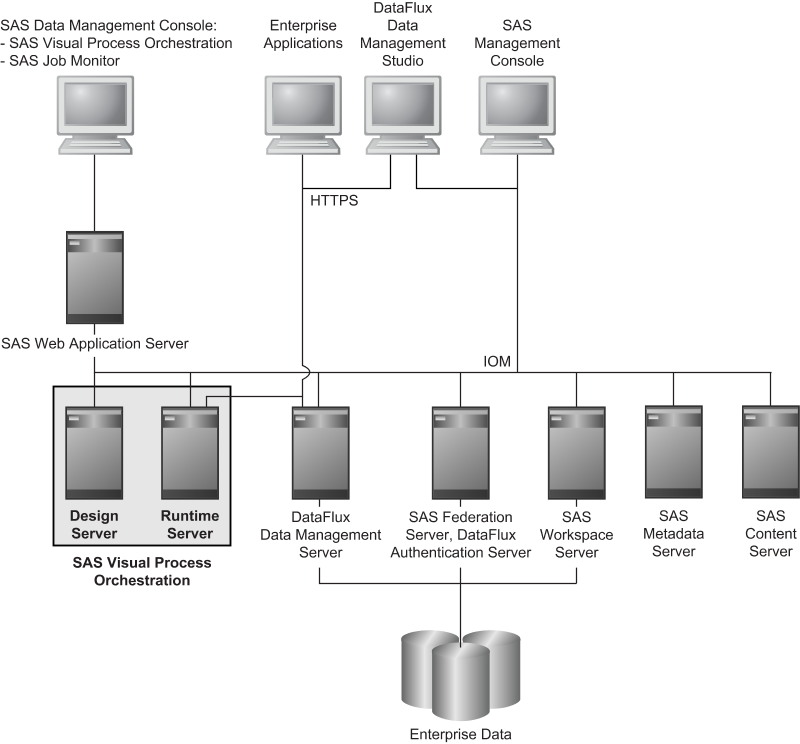SAS Visual Process Orchestration and SAS Data Management
SAS Visual Process Orchestration
is fully integrated with the SAS platform and SAS data management.
The following diagram
shows the main clients and servers that work with SAS Visual Process
Orchestration.
SAS Visual Process Orchestration and SAS Data Management

-
SAS Data Management Console is a framework that displays status information and enables the invocation of data management applications such as SAS Visual Process Orchestration and SAS Job Monitor.
-
SAS Visual Process Orchestration is a web client that enables you to create orchestration jobs, which are process jobs that run other jobs. This client is launched from SAS Data Management Console.
-
If SAS Job Monitor is installed, then the SAS Data Management Console home page contains a link to Monitor Center in SAS Environment Manager. A Monitor Center portlet is displayed on the home page. This portlet displays run-time statistics for monitored jobs, such as orchestration jobs from SAS Visual Process Orchestration.
-
The SAS Web Application Server helps the SAS Visual Process Orchestration Run-time Server coordinate access to resources that are requested by multiple web clients. The web server also works with the SAS Metadata Server to authorize and authenticate users.
-
The SAS Visual Process Orchestration Design Server, working with SAS Content Services, stores orchestration jobs on a SAS Content Server.
-
The SAS Visual Process Orchestration Run-time Server executes orchestration jobs. Each job node within the orchestration job executes in sequence, each on its specified server. The run-time server monitors and reports the status of each job as it runs. The run-time server can deliver job results to your enterprise applications using enhanced-security HTTPS web addresses. HTTPS also enables enterprise applications to trigger the execution of process flows. HTTPS is implemented using Secure Sockets Layer (SSL) technology.
-
DataFlux Data Management Studio enables you to create, test, and upload jobs to DataFlux Data Management Servers. These jobs can be included as part of the flow in an orchestration job.
-
The optional SAS Federation Server and SAS Application Server run data federation jobs that are created in DataFlux Data Management Studio. The data federation jobs collect (federate) data from disparate sources across your enterprise. The resulting data sets can be accessed by the creation of data source names on the federation server and on your enterprise applications.
-
The DataFlux Authentication Server works with the SAS Federation Server to authenticate the users that access jobs, data sets, and enterprise relational databases. The DataFlux Authentication Server can also work with DataFlux Data Management Servers for these same purposes.
-
SAS Data Integration Studio is a rich client that can provide component jobs and real-time services for orchestration jobs.
-
SAS Management Console enables you to maintain metadata definitions for the design and run-time servers and assign roles and capabilities to users. You can also stop, start, and restart the design and run-time servers.
-
The SAS Metadata Server manages metadata definitions for servers, users, and other resources. The metadata server also works with the SAS Web Application Server and with DataFlux Data Management Servers to provide authorization and authentication.
Communication between
clients and servers uses the SAS Integrated Object Model (IOM), which
is based on TCP/IP. All IOM connections are encrypted. The default
encryption algorithm is SASProprietary. You can configure your system
to use the Advanced Encryption Standard (AES). AES features keys lengths
from 128 to 256 bits.
Copyright © SAS Institute Inc. All rights reserved.